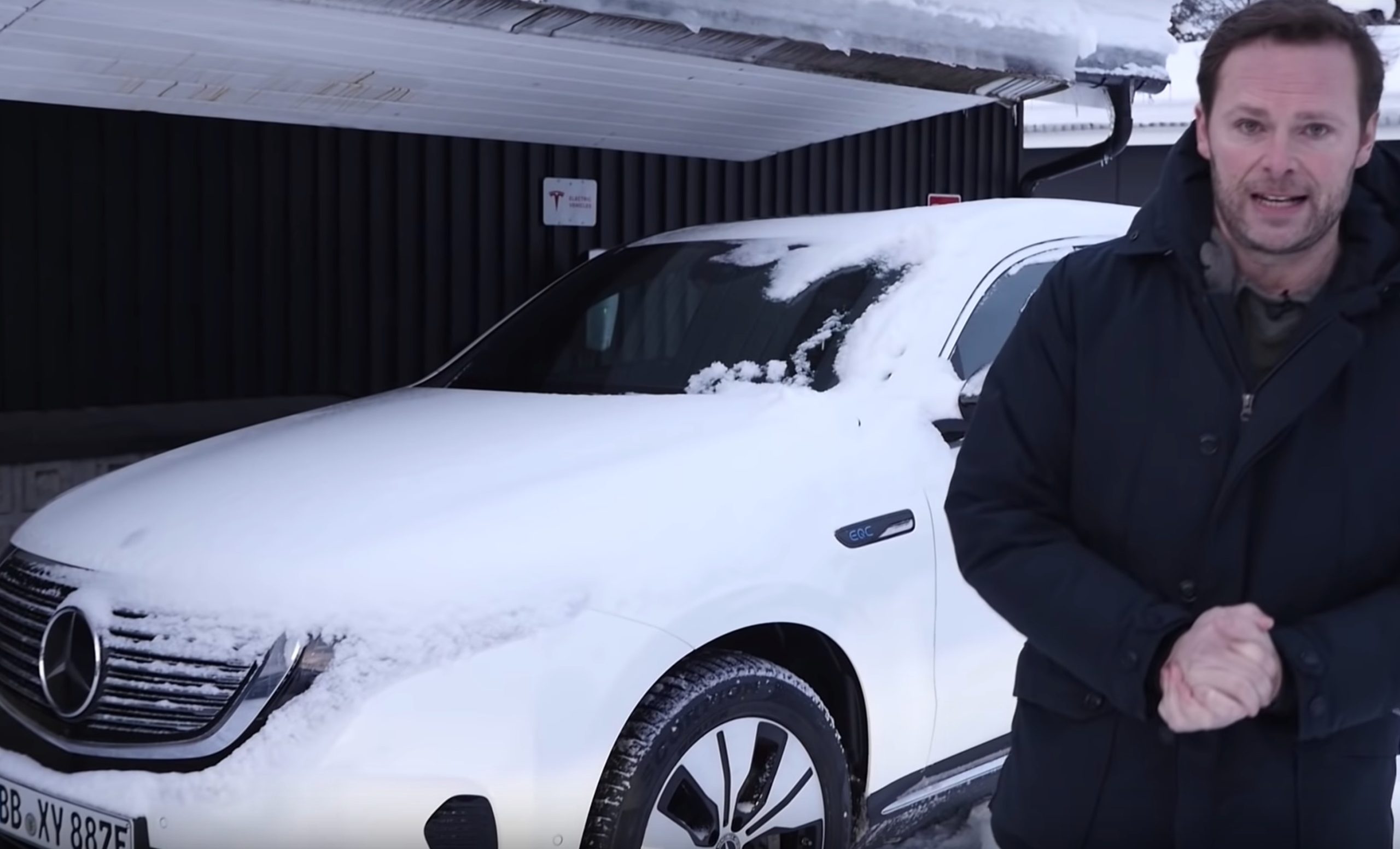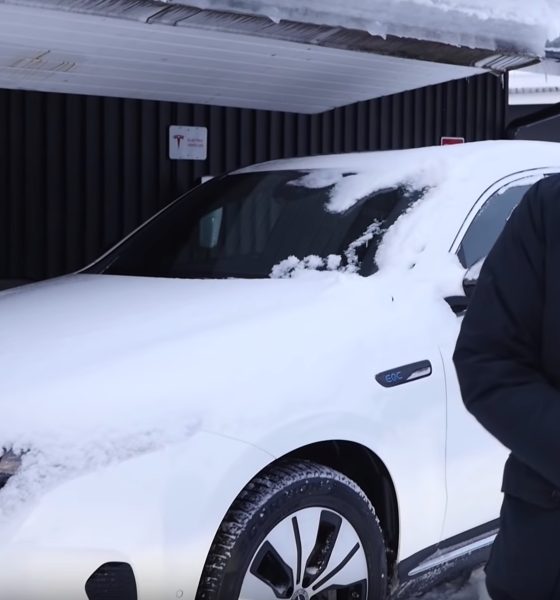

News
Mercedes-Benz EQC spotted mysteriously charging at Tesla destination charger [Update]
A recent video of the Mercedes-Benz EQC has featured the upcoming all-electric SUV topping up its battery at a rather unusual location — a Tesla Destination Charger in Sweden. What’s even more interesting is that the EQC was plugged into a Tesla-specific charger.
Tesla’s Destination Chargers, particularly those in Europe, usually feature two charging units, one red and the other white. Chargers with a red sign are exclusive to Tesla’s electric cars, while those with white signs are open for use by any electric vehicle. German publication auto motor und sport shared a video that seemingly shows the Mercedes-Benz EQC charging from a red, Tesla-exclusive charger, as evidenced by the cable running towards the rear passenger side of the SUV, where its charging port is located, and the charger’s green charging indicator.
The auto publication did not explain how the EQC was able to charge from the Tesla charger, leaving the community to speculate on whether Tesla might be opening its vast network of Superchargers and destination chargers to other carmakers.
[Update]
A Tesla spokesperson has noted that according to company records, the destination charger in auto motor und sport‘s video is equipped with two universal and two Tesla-only connectors. The Mercedes-Benz EQC was connected to a universal charger that was mislabeled as a Tesla-only charging unit.
Elon Musk might dislike the concept of competitive moats, but the company’s charging infrastructure is an undeniable edge against rival electric car makers. Nevertheless, Musk has openly stated in the past that Tesla is open to the idea of sharing its Supercharger Network to other carmakers. The CEO even emphasized his point by stating that Tesla does not in any way intend to make its Superchargers a “walled garden.”
As the company prepares for the EQC’s release, Mercedes-Benz has ramped its efforts to provide the upcoming electric SUV with viable charging infrastructure. Last December, for example, Daimler, which owns Mercedes-Benz, announced that it had selected ChargePoint to deploy charging solutions for retailers in Germany. With this in mind, is it possible that Daimler has also reached out to Tesla with regards to the EQC’s use of the company’s destination chargers? Such an idea is not too farfetched.
It should be noted that Daimler was among Tesla’s major investors in the past, with the Germany-based company taking a 10% stake in the electric car maker in 2009 with a $50 million investment. Over the next years, Tesla supplied electric powertrains for Daimler’s electric Smart Cars and the electric Mercedes-Benz B-Class. Daimler would eventually pull out is stake in the company in 2014. By this time, its $50 million investment had grown to $780 million.
Signs of another possible Tesla-Daimler collaboration have been emerging recently, with Elon Musk and Daimler CEO Dieter Zetsche both mentioning references to an all-electric version of the Mercedes-Benz Sprinter van, which Tesla uses in its service fleet.
Watch auto motor und sport‘s Mercedes Benz EQC feature in the video below.

News
Nvidia CEO Jensen Huang explains difference between Tesla FSD and Alpamayo
“Tesla’s FSD stack is completely world-class,” the Nvidia CEO said.

NVIDIA CEO Jensen Huang has offered high praise for Tesla’s Full Self-Driving (FSD) system during a Q&A at CES 2026, calling it “world-class” and “state-of-the-art” in design, training, and performance.
More importantly, he also shared some insights about the key differences between FSD and Nvidia’s recently announced Alpamayo system.
Jensen Huang’s praise for Tesla FSD
Nvidia made headlines at CES following its announcement of Alpamayo, which uses artificial intelligence to accelerate the development of autonomous driving solutions. Due to its focus on AI, many started speculating that Alpamayo would be a direct rival to FSD. This was somewhat addressed by Elon Musk, who predicted that “they will find that it’s easy to get to 99% and then super hard to solve the long tail of the distribution.”
During his Q&A, Nvidia CEO Jensen Huang was asked about the difference between FSD and Alpamayo. His response was extensive:
“Tesla’s FSD stack is completely world-class. They’ve been working on it for quite some time. It’s world-class not only in the number of miles it’s accumulated, but in the way it’s designed, the way they do training, data collection, curation, synthetic data generation, and all of their simulation technologies.
“Of course, the latest generation is end-to-end Full Self-Driving—meaning it’s one large model trained end to end. And so… Elon’s AD system is, in every way, 100% state-of-the-art. I’m really quite impressed by the technology. I have it, and I drive it in our house, and it works incredibly well,” the Nvidia CEO said.
Nvidia’s platform approach vs Tesla’s integration
Huang also stated that Nvidia’s Alpamayo system was built around a fundamentally different philosophy from Tesla’s. Rather than developing self-driving cars itself, Nvidia supplies the full autonomous technology stack for other companies to use.
“Nvidia doesn’t build self-driving cars. We build the full stack so others can,” Huang said, explaining that Nvidia provides separate systems for training, simulation, and in-vehicle computing, all supported by shared software.
He added that customers can adopt as much or as little of the platform as they need, noting that Nvidia works across the industry, including with Tesla on training systems and companies like Waymo, XPeng, and Nuro on vehicle computing.
“So our system is really quite pervasive because we’re a technology platform provider. That’s the primary difference. There’s no question in our mind that, of the billion cars on the road today, in another 10 years’ time, hundreds of millions of them will have great autonomous capability. This is likely one of the largest, fastest-growing technology industries over the next decade.”
He also emphasized Nvidia’s open approach, saying the company open-sources its models and helps partners train their own systems. “We’re not a self-driving car company. We’re enabling the autonomous industry,” Huang said.
Elon Musk
Elon Musk confirms xAI’s purchase of five 380 MW natural gas turbines
The deal, which was confirmed by Musk on X, highlights xAI’s effort to aggressively scale its operations.

xAI, Elon Musk’s artificial intelligence startup, has purchased five additional 380 MW natural gas turbines from South Korea’s Doosan Enerbility to power its growing supercomputer clusters.
The deal, which was confirmed by Musk on X, highlights xAI’s effort to aggressively scale its operations.
xAI’s turbine deal details
News of xAI’s new turbines was shared on social media platform X, with user @SemiAnalysis_ stating that the turbines were produced by South Korea’s Doosan Enerbility. As noted in an Asian Business Daily report, Doosan Enerbility announced last October that it signed a contract to supply two 380 MW gas turbines for a major U.S. tech company. Doosan later noted in December that it secured an order for three more 380 MW gas turbines.
As per the X user, the gas turbines would power an additional 600,000+ GB200 NVL72 equivalent size cluster. This should make xAI’s facilities among the largest in the world. In a reply, Elon Musk confirmed that xAI did purchase the turbines. “True,” Musk wrote in a post on X.
xAI’s ambitions
Recent reports have indicated that xAI closed an upsized $20 billion Series E funding round, exceeding the initial $15 billion target to fuel rapid infrastructure scaling and AI product development. The funding, as per the AI startup, “will accelerate our world-leading infrastructure buildout, enable the rapid development and deployment of transformative AI products.”
The company also teased the rollout of its upcoming frontier AI model. “Looking ahead, Grok 5 is currently in training, and we are focused on launching innovative new consumer and enterprise products that harness the power of Grok, Colossus, and 𝕏 to transform how we live, work, and play,” xAI wrote in a post on its website.
Elon Musk
Elon Musk’s xAI closes upsized $20B Series E funding round
xAI announced the investment round in a post on its official website.

xAI has closed an upsized $20 billion Series E funding round, exceeding the initial $15 billion target to fuel rapid infrastructure scaling and AI product development.
xAI announced the investment round in a post on its official website.
A $20 billion Series E round
As noted by the artificial intelligence startup in its post, the Series E funding round attracted a diverse group of investors, including Valor Equity Partners, Stepstone Group, Fidelity Management & Research Company, Qatar Investment Authority, MGX, and Baron Capital Group, among others.
Strategic partners NVIDIA and Cisco Investments also continued support for building the world’s largest GPU clusters.
As xAI stated, “This financing will accelerate our world-leading infrastructure buildout, enable the rapid development and deployment of transformative AI products reaching billions of users, and fuel groundbreaking research advancing xAI’s core mission: Understanding the Universe.”
xAI’s core mission
Th Series E funding builds on xAI’s previous rounds, powering Grok advancements and massive compute expansions like the Memphis supercluster. The upsized demand reflects growing recognition of xAI’s potential in frontier AI.
xAI also highlighted several of its breakthroughs in 2025, from the buildout of Colossus I and II, which ended with over 1 million H100 GPU equivalents, and the rollout of the Grok 4 Series, Grok Voice, and Grok Imagine, among others. The company also confirmed that work is already underway to train the flagship large language model’s next iteration, Grok 5.
“Looking ahead, Grok 5 is currently in training, and we are focused on launching innovative new consumer and enterprise products that harness the power of Grok, Colossus, and 𝕏 to transform how we live, work, and play,” xAI wrote.








